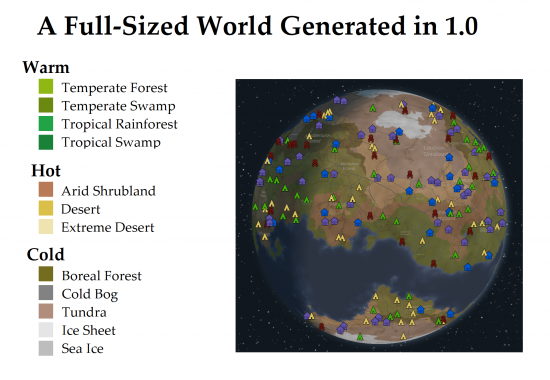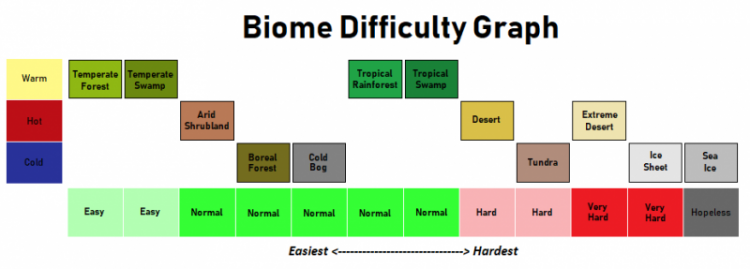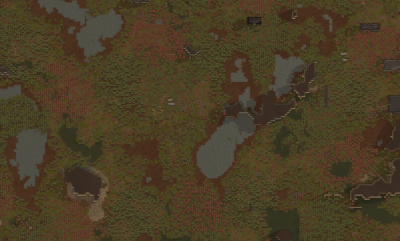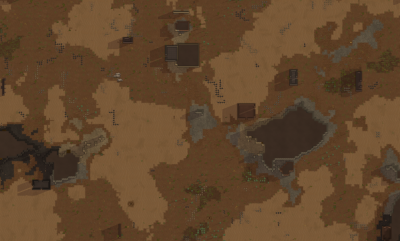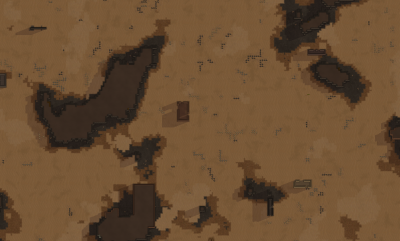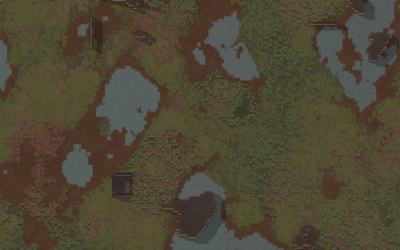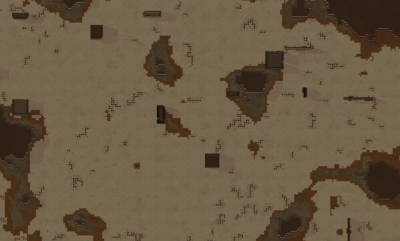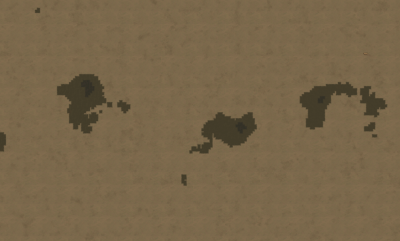Difference between revisions of "World generation"
(Cleaned up tables and various text. Added keyboard controls table.) |
(Set TOC right. Expanded text. Tagged with category Running the game.) |
||
| Line 10: | Line 10: | ||
{{UC}} | {{UC}} | ||
| + | {{TOCright}} | ||
== Basics == | == Basics == | ||
Worlds in RimWorld are generated from either random or user-provided seeds that allow for a completely new experience every time. Each world is uniquely filled with multiple [[Biomes|biomes]] that change what the world looks like and how it behaves. For example, some biomes feature a large amount of mountains, while others are full of grasslands. | Worlds in RimWorld are generated from either random or user-provided seeds that allow for a completely new experience every time. Each world is uniquely filled with multiple [[Biomes|biomes]] that change what the world looks like and how it behaves. For example, some biomes feature a large amount of mountains, while others are full of grasslands. | ||
| − | + | == Create world == | |
| + | The option to create a new world is selected from the game's main menu. The first screen is for setting the seed and world map size. The player may simply choose to continue by clicking Generate. The player may also choose to use the Randomize seed button to generate a new seed or may enter a seed manually. A given seed always produces the same map layout, while the map size determines the (horizontal x vertical) number of map tiles. A larger map size offers a more granular selection of map tiles. For example, an island may appear as one square in a small map size but at a greater size it will consist of multiple selectable squares. The world map size has no effect on the in-game map. | ||
| + | |||
| + | The world is arranged in a grid of individual squares, in one the following sizes: | ||
{| class = "wikitable" width="400px" style = "text-align: center;" | {| class = "wikitable" width="400px" style = "text-align: center;" | ||
|+ Optional map sizes | |+ Optional map sizes | ||
| Line 19: | Line 23: | ||
|} | |} | ||
| − | Every square on a world is unique, with its own biome, elevation, average temperature, terrain, and rainfall amount. | + | Once the player clicks Generate, the Preview World screen appears and shows the world map. Every square on a world is unique, with its own biome, elevation, average temperature, terrain, and rainfall amount. These details are shown whenever the player selects a square. This screen is for previewing the map only and not used for selecting a landing site. When creating a new colony the player will select one of the squares in which to land and build a [[Colony|colony]]. Once the player clicks Save and Finish the game returns to the main menu and the new world appears in the Select World window when creating a new colony. |
| − | + | The following controls are used on the World preview screen: | |
| − | The following controls are used on the World | ||
{| class="wikitable" | {| class="wikitable" | ||
| Line 53: | Line 56: | ||
|} | |} | ||
| − | In world generation four main features | + | In world generation four main features, biome, elevation, temperature, and rainfall, are generated with each tile. Clicking the Mode button (default is 'Full') offers the choice to select a feature to view the map in a special heat map. Each feature is logical with the tiles near to them. Each feature goes along with the biome of the tiles and the tiles around it. Each biome has its unique trees, animals, temperatures, rainfall and growing periods. |
== Features == | == Features == | ||
| − | There are | + | There are five main features that affect game play in that tile on a generated world. These details are listed onscreen for the selected map tile. |
| + | |||
| + | === Terrain === | ||
| + | Each map tile has one of the following terrain types: Flat, Small hills, Large Hills, and Mountains. The terrain type determines the amount of mountain will be generated on the in-game map. | ||
| + | |||
| + | === Rainfall === | ||
| + | Each map tile has a certain amount of rainfall, give in average number of milliliters per year. | ||
| + | |||
| + | === Latitude === | ||
| + | The coordinates of a map tile includes its latitude which affects its temperature range and amount of daylight (unconfirmed). | ||
=== [[Temperature|Temperature]] === | === [[Temperature|Temperature]] === | ||
| Line 65: | Line 77: | ||
There are nine biomes in Rimworld, and on a normally generated world, all of them are represented. They each correspond to specific features. Each biome is more likely to include certain features based on it's real world equivalent. | There are nine biomes in Rimworld, and on a normally generated world, all of them are represented. They each correspond to specific features. Each biome is more likely to include certain features based on it's real world equivalent. | ||
| − | + | {{:Biomes}} | |
| − | |||
| − | + | [[Category:Running the game]] | |
| − | |||
Revision as of 07:16, 16 April 2015
|
|---|
|
Basics
Worlds in RimWorld are generated from either random or user-provided seeds that allow for a completely new experience every time. Each world is uniquely filled with multiple biomes that change what the world looks like and how it behaves. For example, some biomes feature a large amount of mountains, while others are full of grasslands.
Create world
The option to create a new world is selected from the game's main menu. The first screen is for setting the seed and world map size. The player may simply choose to continue by clicking Generate. The player may also choose to use the Randomize seed button to generate a new seed or may enter a seed manually. A given seed always produces the same map layout, while the map size determines the (horizontal x vertical) number of map tiles. A larger map size offers a more granular selection of map tiles. For example, an island may appear as one square in a small map size but at a greater size it will consist of multiple selectable squares. The world map size has no effect on the in-game map.
The world is arranged in a grid of individual squares, in one the following sizes:
| 150x112 | 200x150 | 250x188 | 300x225 | 350x262 | 400x300 |
Once the player clicks Generate, the Preview World screen appears and shows the world map. Every square on a world is unique, with its own biome, elevation, average temperature, terrain, and rainfall amount. These details are shown whenever the player selects a square. This screen is for previewing the map only and not used for selecting a landing site. When creating a new colony the player will select one of the squares in which to land and build a colony. Once the player clicks Save and Finish the game returns to the main menu and the new world appears in the Select World window when creating a new colony.
The following controls are used on the World preview screen:
| Mouse Controls | |||
|---|---|---|---|
| Left mouse button | Select location | ||
| Right mouse button | Clear selection | ||
| Middle mouse button | Pan (click+hold) | ||
| Keyboard Controls | |
|---|---|
| PageUp or E | Zoom out |
| PageDown or F | Zoom in |
| Arrow up or W | Pan up |
| Arrow down or S | Pan down |
| Arrow left or A | Pan Left |
| Arrow right or D | Pan Right |
In world generation four main features, biome, elevation, temperature, and rainfall, are generated with each tile. Clicking the Mode button (default is 'Full') offers the choice to select a feature to view the map in a special heat map. Each feature is logical with the tiles near to them. Each feature goes along with the biome of the tiles and the tiles around it. Each biome has its unique trees, animals, temperatures, rainfall and growing periods.
Features
There are five main features that affect game play in that tile on a generated world. These details are listed onscreen for the selected map tile.
Terrain
Each map tile has one of the following terrain types: Flat, Small hills, Large Hills, and Mountains. The terrain type determines the amount of mountain will be generated on the in-game map.
Rainfall
Each map tile has a certain amount of rainfall, give in average number of milliliters per year.
Latitude
The coordinates of a map tile includes its latitude which affects its temperature range and amount of daylight (unconfirmed).
Temperature
Temperature is one of the more varying features. each tile has its own averages for temperature based on the biome. The only the averages are presented in the world generation menu, but can directly affect your game as your colonists could fry and get heat stroke in extreme heat or freeze to a point that when they die, their bodies of frozen and will never decay. Temperature is related to the other three features of a tile in a generated world. Naturally, higher elevation and a more northern biome is colder.
Biomes
There are nine biomes in Rimworld, and on a normally generated world, all of them are represented. They each correspond to specific features. Each biome is more likely to include certain features based on it's real world equivalent.
|
| This article is suggested to be rewritten. Reason: Verification needed. At least a couple of the growing periods for the biomes are wrong, though their exact ranges are unknown.. You can help the RimWorld Wiki by improving it. |
Biomes are types of area on a planet, characterized by their terrain properties, climate, flora and fauna, diseases and special challenges. Each world tile has one particular biome. There are twelve playable biomes types in RimWorld, which can be divided into three categories: Warm, Hot and Cold. Oceans and lakes appear as world tiles but are not playable biomes.
The following is a simple summary of the biomes by difficulty, overall cold biomes are more challenging than their hot counterparts.
Warm biomes
These biomes are rich in flora and fauna, and also have a slightly elevated rate of disease. They generally have year-round growing periods, or longer growing periods at the very least. Traveling speed is fast in normal forests and average in dense forests but slow in marshes and during cold seasons if they have one.
Temperate forest
Forests of deciduous trees interspersed with fertile clearings. Many species of animals move around among the trees and on the plains.
Growing season, temperature, travel and disease
- Growing Season: From all year to 20/60 days.
- Average Temperature: 25 °C (77 °F) to 0 °C (32 °F).
- Temperature Variation: From 35 °C (95 °F) in summer to -25 °C (-13 °F) in winter.
- Roads and Rivers: Yes.
- Movement Difficulty: 1, but sometimes 3 due to winter.
- Forageability: 100%.
- Grazable: Only during growing season.
- Disease frequency: 1.2 per year.
Flora
Berry bush, Brambles, Bush, Dandelions, Grass, Oak tree, Poplar tree, Tall grass, Wild healroot, Harbinger tree ![]() , Gauranlen tree
, Gauranlen tree ![]() , Timbershroom
, Timbershroom ![]() , Anima tree
, Anima tree ![]()
Fauna
Alpaca, Bison, Boomalope, Boomrat, Cougar, Deer, Donkey, Gazelle, Grizzly bear, Guinea pig, Hare, Horse, Ibex, Lynx, Megasloth, Muffalo, Raccoon, Rat, Red fox, Rhinoceros, Squirrel, Timber wolf, Tortoise, Turkey, Warg, Wild boar, Yak
Temperate swamp
Wetlands choked with vegetation and disease. Dense overgrowth makes it hard to move around, and clearing areas for building takes a long time. Much of the terrain is too marshy to support heavy structures.
A more wet version of the Temperate Forest. Like in all swamps, diseases are more common. The marshy soil will probably require bridges before constructing buildings and the terrain is really slow to travel, but this biome also has more fertile soil.
Growing season, temperature, travel and disease
- Growing Season: From all year to 20/60 days.
- Average Temperature: 25 °C (77 °F) to 0 °C (32 °F).
- Temperature Variation: From 35 °C (95 °F) in summer to -25 °C (-13 °F) in winter.
- Roads and Rivers: Yes.
- Movement Difficulty: 4, but sometimes 6 due to winter.
- Forageability: 75%.
- Grazable: Only during growing season.
- Disease frequency: 1.5 per year.
Flora
Berry bush, Bush, Chokevine, Cypress tree, Maple tree, Tall grass, Wild healroot, Willow tree, Harbinger tree ![]() , Gauranlen tree
, Gauranlen tree ![]() , Timbershroom
, Timbershroom ![]() , Anima tree
, Anima tree ![]()
Fauna
Alpaca, Boomalope, Boomrat, Cougar, Deer, Grizzly bear, Guinea pig, Hare, Horse, Ibex, Lynx, Megasloth, Muffalo, Raccoon, Rat, Red fox, Rhinoceros, Squirrel, Timber wolf, Tortoise, Turkey, Warg, Wild boar, Yak
Tropical rainforest
A thick, moist jungle, buzzing with animal life and infested with disease. Despite its visual beauty, this is a very dangerous biome. Choking overgrowth, aggressive animals, and constant sickness are why some explorers call this the "green hell".
Tropical Rainforests are famous for having many diseases, including Sleeping Sickness: a slow-progressing, long-lasting disease that is exclusive to the tropics. Many trees make it difficult to clear land and rapid plant growth makes it difficult to keep it clear.
Growing season, temperature, travel and disease
- Growing Season: From all year to 40/60 days.
- Average Temperature: 30 °C (86 °F) to 15 °C (59 °F).
- Temperature Variation: From 35 °C (95 °F) in summer to 0 °C (32 °F) in winter.
- Roads and Rivers: Yes.
- Movement Difficulty: 2, rarely 4 due to winter.
- Forageability: 100%.
- Grazable: Most of the time, during growing season.
- Disease frequency: 1.7 per year.
Flora
Alocasia, Bamboo tree, Berry bush, Bush, Cecropia tree, Clivia, Giant rafflesia, Grass, Low shrubs, Palm tree, Tall grass, Teak tree, Harbinger tree ![]() , Gauranlen tree
, Gauranlen tree ![]() , Timbershroom
, Timbershroom ![]() , Anima tree
, Anima tree ![]()
Fauna
Alpaca, Boomalope, Capybara, Cassowary, Chinchilla, Cobra, Elephant, Guinea pig, Monkey, Panther, Rat, Rhinoceros, Tortoise, Wild boar
Tropical swamp
A plant-choked, steamy swamp seething with parasites and pathogens. Much of the land is too marshy to build on. Difficult movement, aggressive animals, and rampant disease make living here a nightmare.
A more wet version of the Tropical Rainforest. Like in all swamps diseases are more common. The marshy soil will probably require bridges before constructing buildings and the terrain is really slow to travel, but this biome also has more fertile soil. Diseases are even more constant here than in Tropical Rainforests, so making a proper hospital and having good doctors is a priority.
Growing season, temperature, travel and disease
- Growing Season: From all year to 40/60 days.
- Average Temperature: 30 °C (86 °F) to 15 °C (59 °F).
- Temperature Variation: From 35 °C (95 °F) in summer to 0 °C (32 °F) in winter.
- Roads and Rivers: Yes.
- Movement Difficulty: 4, rarely 6 due to winter.
- Forageability: 75%.
- Grazable: Most of the time, during growing season.
- Disease frequency: 2.0 per year.
Flora
Alocasia, Berry bush, Bush, Chokevine, Clivia, Cypress tree, Giant rafflesia, Low shrubs, Maple tree, Tall grass, Willow tree, Harbinger tree ![]() , Gauranlen tree
, Gauranlen tree ![]() , Timbershroom
, Timbershroom ![]() , Anima tree
, Anima tree ![]()
Fauna
Alpaca, Boomalope, Capybara, Cassowary, Chinchilla, Cobra, Elephant, Guinea pig, Monkey, Panther, Rat, Rhinoceros, Tortoise, Wild boar
Hot biomes
These biomes become progressively dry as they become more arid. Moderate amount of flora and fauna, which drops off as you pick a more extreme biome. Mostly year-round growing periods. Traveling in those biomes is usually fast and rarely slowed by cold seasons.
Arid shrubland
A dry region, but not dry enough to become a true desert. Open plains with grasses and bushes give way to scattered groves of trees. Plants are hardy and there is a moderate density of animals, but arable soil is hard to find.
Growing season, temperature, travel and disease
- Growing Season: From all year to 40/60 days.
- Average Temperature: 30 °C (86 °F) to 15 °C (59 °F).
- Temperature Variation: From 35 °C (95 °F) in summer to 0 °C (32 °F) in winter.
- Roads and Rivers: Yes.
- Movement Difficulty: 1, rarely 3 due to winter.
- Forageability: 50%.
- Grazable: Most of the time, during growing season.
- Disease frequency: 0.9 per year.
Flora
Agave, Berry bush, Bush, Dandelions, Drago tree, Grass, Pincushion cactus, Saguaro cactus, Harbinger tree ![]() , Gauranlen tree
, Gauranlen tree ![]() , Timbershroom
, Timbershroom ![]() , Anima tree
, Anima tree ![]()
Fauna
Bison, Boomalope, Boomrat, Cougar, Donkey, Dromedary, Elephant, Emu, Fennec fox, Gazelle, Guinea pig, Hare, Horse, Iguana, Megasloth, Ostrich, Rat, Rhinoceros
Desert
A very dry area which supports little life. There is very little arable land, and animal life is very sparse. Deserts can be hot, or quite cold.
With so few animals to hunt, growing crops is a priority on one of the few arable patches. The hot temperatures can cause problems for colonists and tamed animals. This biome has patches of soft sand which prevent building, but can be removed with moisture pumps.
Growing season, temperature, travel and disease
- Growing Season: From all year to 10/60 days.
- Average Temperature: 30 °C (86 °F) to 0 °C (32 °F).
- Temperature Variation: From 35 °C (95 °F) in summer to -25 °C (-13 °F) in winter.
- Roads and Rivers: Yes.
- Movement Difficulty: 1, but sometimes 3 due to winter.
- Forageability: 25%.
- Grazable: Only during growing season.
- Disease frequency: 0.7 per year.
Flora
Agave, Bush, Dandelions, Drago tree, Grass, Pincushion cactus, Saguaro cactus, Harbinger tree ![]() , Gauranlen tree
, Gauranlen tree ![]() , Timbershroom
, Timbershroom ![]() , Anima tree
, Anima tree ![]()
Fauna
Boomalope, Cougar, Donkey, Dromedary, Emu, Fennec fox, Gazelle, Guinea pig, Iguana, Ostrich
Extreme desert
An extremely hot, dry area, devoid of almost all life. Searing heat and a near total lack of arable land make it very difficult to survive here.
The hot temperatures can cause problems for colonists and tamed animals. Its warm enough for growing plants outdoors, but it has to be done in stony patches around hills and mountains. Even though potatoes grows better in stony soil, you need to plant rice first so you will not starve while waiting for potatoes. Strawberries are also a good idea since there is no wood for cooking. Later hydroponics can be used instead of ground. This biome has patches of soft sand which prevent building, but can be removed with moisture pumps. Animal migrations may occur, about once every other year.
Growing season, temperature, travel and disease
- Growing Season: From all year to 30/60 days.
- Average Temperature: 30 °C (86 °F) to 10 °C (50 °F).
- Temperature Variation: From 35 °C (95 °F) in summer to -5 °C (23 °F) in winter.
- Roads and Rivers: Yes.
- Movement Difficulty: 1, rarely 3 due to winter.
- Forageability: 0%.
- Grazable: Never.
- Disease frequency: 0.7 per year.
Flora
Agave, Grass, Saguaro cactus, Gauranlen tree ![]() , Timbershroom
, Timbershroom ![]()
Fauna
Donkey, Dromedary, Fennec fox, Guinea pig, Iguana
Cold biomes
These biomes become progressively colder and hostile as they become more intense. Flora and fauna becomes more scarce as you pick a more extreme biome. Mostly seasonal growing periods but may go down to no growing period in more extreme biomes. Traveling in those biomes is usually slow due to marsh and cold seasons which can be very long.
Boreal forest
Forests of coniferous trees. Despite the harsh winters, boreal forests sustain a diverse population of small and large animals, and have warm summers.
Growing season, temperature, travel and disease
- Growing Season: 30/60 days to 10/60 days.
- Average Temperature: 10 °C (50 °F) to -10 °C (14 °F).
- Temperature Variation: From 25 °C (77 °F) in summer to -35 °C (-31 °F) in winter.
- Roads and Rivers: Yes.
- Movement Difficulty: 1, but often 3 due to winter.
- Forageability: 75%.
- Grazable: Only during growing season.
- Disease frequency: 1.0 per year.
Flora
Berry bush, Birch tree, Brambles, Bush, Grass, Moss, Pine tree, Poplar tree, Wild healroot, Harbinger tree ![]() , Gauranlen tree
, Gauranlen tree ![]() , Timbershroom
, Timbershroom ![]() , Anima tree
, Anima tree ![]()
Fauna
Arctic fox, Arctic wolf, Caribou, Cougar, Deer, Elk, Grizzly bear, Hare, Horse, Ibex, Lynx, Megasloth, Muffalo, Raccoon, Rat, Red fox, Squirrel, Timber wolf, Turkey, Warg, Wild boar, Yak
Cold bog
A wetland packed with trees and vines. Much of the marshy land here can't support heavy structures, moving around is slow due to choking vegetation. Disease is endemic in this dense, wet ecosystem.
A more wet version of the Boreal Forest. Like in all swamps, diseases are more common. The marshy soil will probably require bridges before constructing buildings and the terrain is really slow to travel, but this biome also has more fertile soil.
Growing season, temperature, travel and disease
- Growing Season: 30/60 days to 10/60 days.
- Average Temperature: 10 °C (50 °F) to -10 °C (14 °F).
- Temperature Variation: From 25 °C (77 °F) in summer to -35 °C (-31 °F) in winter.
- Roads and Rivers: Yes.
- Movement Difficulty: 4, but often 6 due to winter.
- Forageability: 50%.
- Grazable: Only during growing season.
- Disease frequency: 1.3 per year.
Flora
Astragalus, Berry bush, Bush, Chokevine, Cypress tree, Maple tree, Moss, Tall grass, Wild healroot, Willow tree, Harbinger tree ![]() , Gauranlen tree
, Gauranlen tree ![]() , Timbershroom
, Timbershroom ![]() , Anima tree
, Anima tree ![]()
Fauna
Arctic fox, Arctic wolf, Caribou, Cougar, Deer, Elk, Grizzly bear, Guinea pig, Hare, Ibex, Lynx, Megasloth, Muffalo, Polar bear, Raccoon, Rat, Red fox, Squirrel, Timber wolf, Turkey, Warg, Wild boar, Yak
Tundra
These mostly-frozen plains bear almost no trees and little vegetation. There are a few small animals interspersed with large herds of migratory grazers and their predators. Animal migrations may occur once or twice per year.
Growing periods are generally very short or non-existent.
Growing season, temperature, travel and disease
- Growing Season: 20/60 days to never.
- Average Temperature: 0 °C (32 °F) to -20 °C (-4 °F).
- Temperature Variation: From 25 °C (77 °F) in summer to -50 °C (-58 °F) in winter.
- Roads and Rivers: Yes.
- Movement Difficulty: 1, but most of the time 3 due to winter.
- Forageability: 50%.
- Grazable: Only during growing season.
- Disease frequency: 0.8 per year.
Flora
Astragalus, Berry bush, Birch tree, Bush, Dandelions, Grass, Moss, Pine tree, Wild healroot, Harbinger tree ![]() , Gauranlen tree
, Gauranlen tree ![]() , Timbershroom
, Timbershroom ![]() , Anima tree
, Anima tree ![]()
Fauna
Arctic fox, Arctic wolf, Caribou, Elk, Grizzly bear, Hare, Ibex, Lynx, Megasloth, Muffalo, Polar bear, Snowhare, Timber wolf, Warg
Ice sheet
Sheets of ice which can be kilometers thick. There is no soil for plants to grow in. The only animals here are migrating to somewhere else - or badly lost.
The only land possible to farm is stony patches around hills and mountains, but they need to be heated indoors and also have sun lamps. You will need to hunt, trade and cannibalize until you get a heater and a sun lamp. Later, moisture pumps can create larger growable areas and hydroponics can be used instead of ground. Geothermal vents can be used for free heating. With so few animals here, any predators that roam in will become hungry soon and target your colonists and animals.
Ice sheet never have ruins.
Growing season, temperature, travel and disease
- Growing Season: Never.
- Average Temperature: -20 °C (-4 °F) to -40 °C (-40 °F).
- Temperature Variation: From 10 °C (50 °F) in summer to -70 °C (-94 °F) in winter.
- Roads and Rivers: No.
- Movement Difficulty: 1.5, but most of the time 3.5 due to winter.
- Forageability: 0%.
- Grazable: Never.
- Disease frequency: 0.7 per year.
Flora
None.
Fauna
Arctic fox, Arctic wolf, Lynx, Megasloth, Muffalo, Polar bear, Snowhare
Sea ice
Permanent ice sheets floating on water. There is no soil for plants to grow, no minerals to mine, and almost no animal life.
Sea Ice does not have ruins and geothermal vents. Deep drills cannot dig up stone chunks and moisture pumps will only generate more ice, which means it is impossible to grow anything on the ground. You will need to do hunting, trading and cannibalism until you get a heater, a sun lamp and a hydroponics basin. It is worth mentioning that Sea Ice was designed to not allow colony building, only to allow traveling in the area, even though it is possible.
Growing season, temperature, travel and disease
- Growing Season: Never.
- Average Temperature: -20 °C (-4 °F) to -30 °C (-22 °F).
- Temperature Variation: From 10 °C (50 °F) in summer to -60 °C (-76 °F) in winter.
- Roads and Rivers: No.
- Movement Difficulty: 1.5, but most of the time 3.5 due to winter.
- Forageability: 0%.
- Grazable: Never.
- Disease frequency: 0.7 per year.
Flora
None.
Fauna
Arctic fox, Arctic wolf, Muffalo, Polar bear, Snowhare
